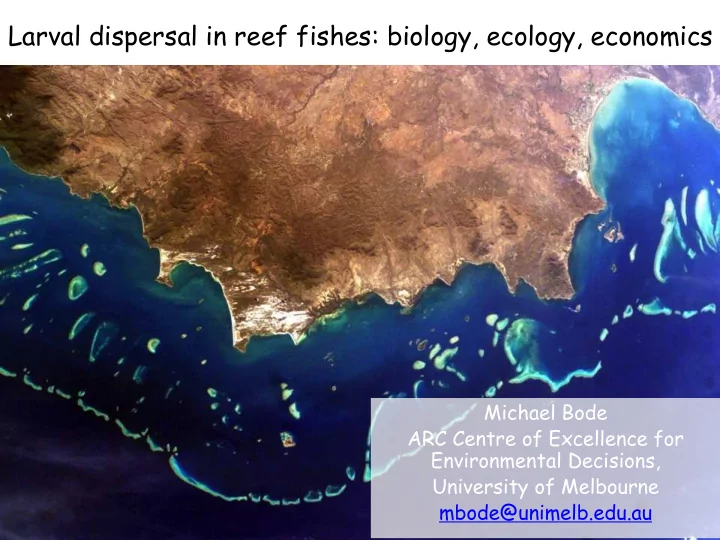

Larval dispersal in reef fishes: biology, ecology, economics Michael Bode ARC Centre of Excellence for Environmental Decisions, University of Melbourne mbode@unimelb.edu.au
Early research into tropical fish communities
Population dynamics on a single patch Nonlinear dynamics in the absence of dispersal: i
Population dynamics on a single patch Recruitment limitation: Doherty (1991) Ecology of Fishes on Coral Reefs
Population dynamics on multiple patches
Dispersal is essentially a linear coupling of a multidimensional nonlinear system • Dispersal is defined by connectivity matrix C • Matrix elements are the proportion of larvae from reef i that travel to reef j 1 2 3
Dispersal is essentially a linear coupling of a multidimensional nonlinear system • Dispersal is defined by connectivity matrix C • Matrix elements are the proportion of larvae from reef i that travel to reef j 1 2 3
Measuring dispersal P. maculatus. Harrison et al. (2012) Current Biology
• Resource intensive • Invasive – individual & species level • Scale limited – (temporal and spatial)
Part 1: Modelling dispersal
Modelling dispersal
Connectivity patterns ( d ) 14 Source reef 16 18 14 16 18 Destination reef
Inter-annual variation
Inter-specific variation
Part 2: Dispersal and coexistence
Coexistence needs differences
Reef fish community theory
Metacommunity simulation • Real distribution of reefs ( P = 110) • Variable dispersal matrices ( t = 1, …, 32 years) • Multiple species ( S = 5) – Identical competitors – Identical niches – Different dispersal behaviour Normally we would expect monodominance
(%)
Dispersal differences and coexistence • Same model • Two species, identical at a local scale • Larval dispersal stages of slightly different lengths. • Three identical patches
Dispersal differences and coexistence
Dispersal differences and coexistence
Coexistence is possible if each species is a superior disperser over one of the inter-patch distances
Coexistence is possible if each species is a superior disperser over one of the inter-patch distances Mechanism has high predictive power for larger simulations
Dispersal differences support coexistence that: • Is simple and intuitive • Driven by common factors • Can create quite complex patterns • Creates stable geographic replacement
Mechanisms ¡ are ¡not ¡locally ¡ observable. ¡
Part 3: Economic perspectives on dispersal
Measuring dispersal on Manus Island Mbunai Locha Pere Timonai Tawi Plectropomus areolatus. Source: FAO
Bioeconomic scales on Manus
Bioeconomic scales on Manus Community tenure areas Spawning aggregation source areas
Management question • What is the maximum annual equilibrium harvest rate from each spawning aggregation? • How do dispersal externalities affect the harvesting decision?
Harvested population model Plectropomus areolatus. Source: FAO
Harvested population model
Harvested population model Simulation model Population estimates
Independent communities • Each community chooses: – a harvest rate on each of their aggregations, – that maximises total equilibrium harvest. – given that other communities act rationally.
Harvests under different coalitions • Communities are highly heterogeneous • Describe coalition structures using partitions e.g., C 0 = {{1} {2} {3} {4} {5}} C 1 = {{1} {2},{3} {4,5}} C 2 = {{1,2,3} {4,5}} C G = {1,2,3,4,5} – 52 unique coalition structures
Harvest coalition size • Non-cooperative groups remove 12-25% / FSA / yr • Cooperative harvests remove 10-17% • Grand coalition improve overall catch (by 15%) and equilibrium population levels (by 70%)
Harvest coalition size • The current scale of management on Manus could lead to undesirable outcomes. • A grand coalition would result in an increase in catches in every community, for much lower effort
Grand coalition stability Group 2 leaves coalition
Grand coalition stability • The grand coalition surplus is insufficient for a set of side-payments to yield rational cooperation.
Smaller coalitions • The coalition between Locha and Pere is the only Nash equilibrium (internal & external stability). • Almost all the resultant benefits are captured by the adjacent communities: Tawi and Mbunai Mbunai Locha Pere Timonai Tawi
Economic impacts of larval dispersal • The scale of larval dispersal creates interconnections between communities • The dissonant scales causes problems. – Too much dispersal to ignore each other – Too much dispersal to want to cooperate – Not enough dispersal to provide necessary surplus
Collaborators Maurice James • Paul Armsworth • Glenn Almany • Lance Bode • Rick Hamilton • Luciano Mason • Geoff Jones • David Williamson •
Recommend
More recommend